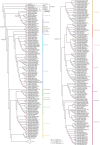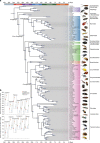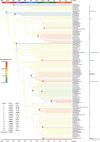Evolutionary history of Coleoptera revealed by extensive sampling of genes and species
- PMID: 29335414
- PMCID: PMC5768713
- DOI: 10.1038/s41467-017-02644-4
Evolutionary history of Coleoptera revealed by extensive sampling of genes and species
Abstract
Beetles (Coleoptera) are the most diverse and species-rich group of insects, and a robust, time-calibrated phylogeny is fundamental to understanding macroevolutionary processes that underlie their diversity. Here we infer the phylogeny and divergence times of all major lineages of Coleoptera by analyzing 95 protein-coding genes in 373 beetle species, including ~67% of the currently recognized families. The subordinal relationships are strongly supported as Polyphaga (Adephaga (Archostemata, Myxophaga)). The series and superfamilies of Polyphaga are mostly monophyletic. The species-poor Nosodendridae is robustly recovered in a novel position sister to Staphyliniformia, Bostrichiformia, and Cucujiformia. Our divergence time analyses suggest that the crown group of extant beetles occurred ~297 million years ago (Mya) and that ~64% of families originated in the Cretaceous. Most of the herbivorous families experienced a significant increase in diversification rate during the Cretaceous, thus suggesting that the rise of angiosperms in the Cretaceous may have been an 'evolutionary impetus' driving the hyperdiversity of herbivorous beetles.
Conflict of interest statement
The authors declare no competing financial interests.
Figures





Similar articles
-
New insights into the phylogeny and evolution of lady beetles (Coleoptera: Coccinellidae) by extensive sampling of genes and species.Mol Phylogenet Evol. 2021 Mar;156:107045. doi: 10.1016/j.ympev.2020.107045. Epub 2021 Jan 5. Mol Phylogenet Evol. 2021. PMID: 33352317
-
High-level phylogeny of the Coleoptera inferred with mitochondrial genome sequences.Mol Phylogenet Evol. 2016 Nov;104:99-111. doi: 10.1016/j.ympev.2016.08.002. Epub 2016 Aug 3. Mol Phylogenet Evol. 2016. PMID: 27497607
-
Mitochondrial genomes of three Bostrichiformia species and phylogenetic analysis of Polyphaga (Insecta, Coleoptera).Genomics. 2020 Sep;112(5):2970-2977. doi: 10.1016/j.ygeno.2020.05.012. Epub 2020 May 15. Genomics. 2020. PMID: 32417292
-
Charles Darwin, beetles and phylogenetics.Naturwissenschaften. 2009 Nov;96(11):1293-312. doi: 10.1007/s00114-009-0601-2. Epub 2009 Sep 17. Naturwissenschaften. 2009. PMID: 19760277 Review.
-
Gene regulatory networks underlying the development and evolution of plasticity in horned beetles.Curr Opin Insect Sci. 2023 Dec;60:101114. doi: 10.1016/j.cois.2023.101114. Epub 2023 Sep 13. Curr Opin Insect Sci. 2023. PMID: 37709168 Review.
Cited by
-
The first report of complete mitogenomes of two endangered species of genus Propomacrus (Coleoptera: Scarabaeidae: Euchirinae) and phylogenetic implications.PLoS One. 2024 Sep 18;19(9):e0310559. doi: 10.1371/journal.pone.0310559. eCollection 2024. PLoS One. 2024. PMID: 39292737 Free PMC article.
-
Phylogeny, morphology, and behavior of the new ciliate species Stentor stipatus.bioRxiv [Preprint]. 2024 Aug 4:2024.08.03.606273. doi: 10.1101/2024.08.03.606273. bioRxiv. 2024. PMID: 39131352 Free PMC article. Preprint.
-
Global biogeographic regions for ants have complex relationships with those for plants and tetrapods.Nat Commun. 2024 Jul 5;15(1):5641. doi: 10.1038/s41467-024-49918-2. Nat Commun. 2024. PMID: 38969636 Free PMC article.
-
Comparative mitogenome research revealed the phylogenetics and evolution of the superfamily Tenebrionoidea (Coleoptera: Polyphage).Ecol Evol. 2024 Jun 25;14(6):e11520. doi: 10.1002/ece3.11520. eCollection 2024 Jun. Ecol Evol. 2024. PMID: 38932962 Free PMC article.
-
Chromosome-Level Genome Assembly of Apoderus dimidiatus Voss (Coleoptera: Attelabidae): Insights into Evolution and Behavior.Insects. 2024 Jun 6;15(6):431. doi: 10.3390/insects15060431. Insects. 2024. PMID: 38921146 Free PMC article.
References
-
- Ślipiński, S. A., Leschen, R. A. B. & Lawrence, J. F. in Animal biodiversity: an outline of higher-level classification and survey of taxonomic richness Vol. 3148 (ed Zhang, Z.-Q.) 203–208 (2011). - PubMed
-
- Grove SJ, Stork NE. An inordinate fondness for beetles. Invertebr. Taxon. 2000;14:733–739. doi: 10.1071/IT00023. - DOI
-
- Crowson, R. A. The Biology of the Coleoptera (Acadamic Press, 1981).
-
- Crowson, R. A. The Natural Classification of the Families of Coleoptera (Nathaniel Lloyd, 1955).
-
- Crowson RA. The phylogeny of Coleoptera. Annu. Rev. Entomol. 1960;5:111–134. doi: 10.1146/annurev.en.05.010160.000551. - DOI
Publication types
MeSH terms
Substances
LinkOut - more resources
Full Text Sources
Other Literature Sources


